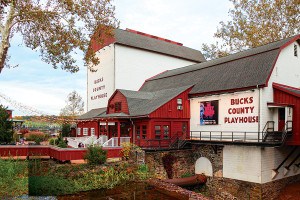NoLibs Neighbors Split Down Middle on Dwell

The warehouse that would be demolished if Dwell Northern Liberties gets built. Photo: Sandy Smith.
It might seem strange that in the neighborhood the Piazza finally put on the map once and for all, residents still have problems swallowing large apartment buildings.
But it took Bart Blatstein about two years and dozens of meetings like the one the Northern Liberties Neighbors Association held on March 26 to get the Piazza into its final form. And if that March 26 meeting is any guide, NoLibs resident Clay Chandler, CEO of The Klein Company, can expect to have several more himself before his company’s Dwell Northern Liberties development finally makes its way through the zoning variance gauntlet.
The 109-unit, two-building apartment complex at 312 Fairmount Ave. is the first in-city project for the Philly-based developer of luxury apartments. Chandler’s initial proposal the previous month received a warm response from several neighbors in attendance, but others, including several members of the NLNA Zoning Committee, objected to its exterior design and its height along a few of the streets it will face.
So architect JKR Partners returned with a design that answered those objections. JKR architect Jose Fernandez walked the attendees through each of them: the white metal panels with orange accents were gone, replaced by brick that the committee felt would blend in better with the neighborhood. Some fifth-floor units were removed from the Galloway Street side of the buildings, and some fourth-floor ones from the Fourth Street side, to bring the top-floor cornice lines closer to those of its neighbors and allow more light and air to reach the streets. The one request the developer and architect ignored was to move the truck loading dock from Fourth Street onto Fairmount Avenue; Hernandez explained that doing so would mangle the Fairmount Avenue facade and reduce the possibility for retail or amenity space to succeed on the street floor.
So this time, many of the residents who attended the meeting had a different complaint: The building is simply too large.
“It looks like you dropped a hospital there,” one resident said. “It’s hard to fathom 108 units there,” said another.
“It’s hard to fathom because it’s not our job,” said Zoning Committee Chair Larry Freedman. He told the audience that the City Planning Commission had taken a look at the proposal and thought it just fine; in fact, the commission was prepared to recommend changing its lot’s zoning from ICMX to IRMX to allow it to proceed by right but instead decided to let the neighborhood weigh in on it first.
Freedman himself reminded some of those neighbors what sort of neighborhood they had moved into. When one resident called NoLibs “a neighborhood of row houses,” Freedman replied, “No, it isn’t. This was an industrial neighborhood.” The structure that Dwell will replace, he noted, was “a building,” not a row home. “They don’t want it to look like Gladwyne, a neighborhood of all single-family homes,” he said of the Planning Commission. “We do have a variety of housing here, not just single-family homes. That’s part of the plan,” said another member of the committee.
This tension between industrial past and residential present has surfaced before, and it came to the fore dramatically when Freedman asked for a show of hands from the 20 neighbors in attendance. “How many people right now, with the changes they made last month, are OK with this project?” he asked. Ten hands went up. “How many people are not OK with it and would like to see it reduced in size?” The other ten hands went up.
As the neighbors continued to talk out the issue, a variety of reasons behind the objections came up. Some feared the project would turn into one big frat house – something Chandler himself had said the project would not become because of its target demographic and price point at the February presentation. Others objected to its height, and one recommended taking out the third floor to reduce it. However, as Freedman and other residents noted, taller buildings than this one already stand in the neighborhood. “The Planning Commission would say, ‘This was zoned industrial, the height was allowed, you should have known that when you moved in,'” Freedman said.
But the NLNA Zoning Committee is famous for seeking consensus in drafting its responses to development proposals, and it strove mightily to incorporate the neighbors’ split opinion in the motion it adopted. That motion began: “The addition of brick to the facade and the Fourth Street and Galloway Street setbacks still do not help this massive apartment building fit into the community. Its height and number of units should be reduced.” It went on to recommend removing units along three frontages, including a small residential alley called Potts Street lined with low-rise houses, in order to reduce that height; ensuring that the street-level commercial or amenity space be open to the whole community, not just the residents; incorporating green features, including a green roof, into the design; reusing old materials in the lobby, and meeting with the Potts Street neighbors to discuss their concerns.
The end result of all these changes would be a building with 15 fewer units and one less story. The next move is the Klein Company’s.


